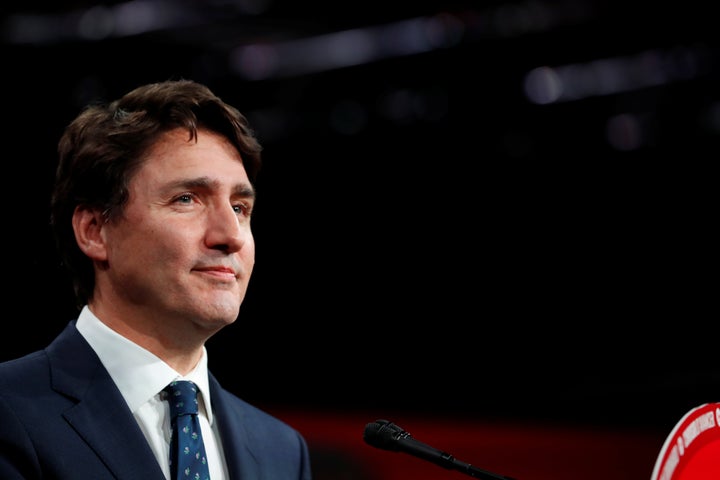
***
It was an inauspicious start. A hurricane changed the Liberals’ original plan to kick off the election campaign on Sept. 9. So with hundreds of thousands without power in Nova Scotia, Justin Trudeau was forced to delay the election call for two days — to Sept. 11.
While Trudeau’s 2015 victory was based on having a plan and sticking to it, the Liberals’ 2019 win was just the opposite.
Liberal campaign director Jeremy Broadhurst said the election call was one of several instances during this campaign when the team pivoted to respond to external events. “It’s something that I take personal pride in that we were able to adjust to things. We didn’t have a script that we wrote in the summer that we refused to deviate from,” he said.
‘Not as advertised’
Andrew Scheer’s Conservatives entered this campaign believing they could win. Trudeau’s brand had taken a beating. An embarrassing trip to India. Compounding ethics scandals. Months of allegations and innuendos from two of his own cabinet ministers. Blow-back from broken promises.
Polls suggested Trudeau would be a one-term prime minister. By summer 2018, he had become less popular than Donald Trump and just as popular as Stephen Harper right before his resounding defeat in 2015.
He was increasingly considered, as the Tories branded him, “not as advertised.” And, in a few weeks, when pictures of Trudeau in blackface emerged, many Liberals and Conservatives would believe the scandal insurmountable.
But Trudeau survived. He remains prime minister. His Liberals will form a government.

Given the choice, most Canadians rejected Scheer, his primary opponent. Not since 2004 have voters in Canada’s most populous provinces, Ontario and Quebec, shunned the Conservatives as soundly as they did on Oct. 21.
The Grits stayed afloat by holding Ontario. They created a stronger narrative, turned what was expected to be a weakness — their carbon pricing plan and environmental record — into an asset, capitalized on their opponent’s vulnerabilities, and leveraged big data to direct their efforts.
This is the inside story of the Liberals’ 2019 election campaign, seen through the eyes of more than 35 sources, including the parties’ top decision makers. Most of them agreed to speak on condition of anonymity.
It was January, and the Liberal caucus was having its first meeting in Parliament’s West Block. Trudeau’s principal secretary, Gerald Butts, told the group what he’d been telling the cabinet and senior staff the previous year: The election needed to be framed as a choice between competing visions for the country, not as an evaluation of the Liberal leader’s last 3½ years in office.
A week later, news that Liberal cabinet minister Jody Wilson-Raybould had been pressured by the Prime Minister’s Office to offer a deferred prosecution agreement to Quebec engineering firm SNC-Lavalin landed on the front page of The Globe and Mail.
As the allegations took centre stage, with key members of the Trudeau government testifying in open committee hearings (including Butts, who quit the PMO) and the prime minister’s honesty in question, the Conservatives’ polling numbers moved upward. And they stayed there.
Two years ago, when Andrew Scheer narrowly beat Maxime Bernier to become the leader of the Conservative Party of Canada, few in the Tory establishment believed the 2019 election would be competitive.
But things had shifted.
THE PARTIES’ PLANS
Scheer’s campaign manager, Hamish Marshall, saw potential in Ontario Progressive Conservative Premier Doug Ford’s victory — and even in his Toronto mayoral loss, as Ford won wards that were 70 per cent visible minorities.
Marshall and the Tories planned to mobilize their base, reach out to women and new immigrants and depress Liberal voters. Their appeal would be geared toward centre-right voters: they would scrap the carbon tax but arm their candidates with a sellable environmental plan focused on new technology and popular home retrofits. Their affordability message was aimed at families in suburban areas struggling to make ends meet despite the rosy economic message the Liberal government liked to trumpet.
Butts’ advice — not to make the 2019 campaign a referendum on Trudeau — was later viewed in some corners of the Liberal party as an acknowledgement that they had done a bad job of communicating their record to Canadians. Many incumbents felt that way, especially those in ridings where the Liberals’ policies — on the environment, poverty, taxes, job growth and infrastructure — were popular but the prime minister wasn’t.
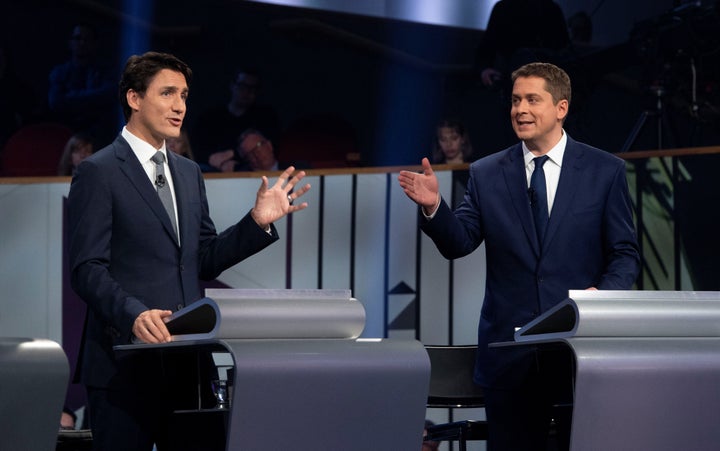
Both the Liberals’ and Conservatives’ plans to victory cut through Quebec. The Liberals would need more seats there (they held 40 of 78 and thought 50 was possible) to hold on to their majority and offset expected losses in Atlantic Canada and Ontario.
The Tories had spent considerable resources building a Quebec team with strong local candidates and an appeal to nationalist voters — a message that had seen success with Richard Martel’s byelection win in Chicoutimi–Le Fjord in 2018.
The NDP knew it faced a near wipeout in Quebec. Leader Jagmeet Singh, a Canadian Sikh of Indian descent who wears a turban, was going to be a tough sell in a province that had just passed Bill 21. The law bars people in public positions of authority, such as teachers, judges and police officers, from wearing religious symbols on the job.
Focus groups assembled by the NDP in the lead-up to the campaign suggested that people liked Singh but needed help seeing beyond the turban and the religious orthodoxy they felt it represented. The plan was to demystify his turban — rather successfully done in a French campaign ad that showed Singh’s long hair uncovered — while reminding voters that he shared their beliefs on important social matters that might seem at odds with his religion, such as gay rights.
The party hoped to put its leader in front of as many people as it could but was hampered by its precarious financial position. The NDP planned to spend up to $12 million on the campaign, less than half the $29-million cap the Liberals and the Tories planned to spend.
The NDP would focus its efforts first on saving incumbent seats, and second on traditionally friendly territory and areas of potential growth. That meant in Ontario and B.C., where the provincial NDP held seats, and ridings where the federal party had strong incumbents in the past, such as Toronto Danforth, Winnipeg Centre, St. John’s East and Niagara Centre.
“That plan did not shift,” campaign co-chair Maria Della Matia said.
Green optimism
The Green Party, meanwhile, was planning to capitalize on the electorate’s growing interest in climate change. A byelection win had doubled leader Elizabeth May’s caucus, and provincial success in P.E.I., N.B., Ontario and B.C. suggested momentum.
Always the optimist, May mused about reaching official party status in the House of Commons (12 seats) but, more realistically, she believed six to eight seats were possible. The party gambled the growth would come from Vancouver Island and put resources there. “If we don’t have the success we think we do, we’ll have to make some changes,” the party’s national campaign manager Jonathan Dickie told HuffPost in July. (On Monday, May announced she is stepping down as leader of the party.)

The Liberals believed convincing progressive voters to support them was key to their victory. Polling that showed the Tories ahead, or the Liberals and Conservatives neck-and-neck, helped convey that message.
Trudeau’s team planned to tie Scheer and Ford together by contrasting the Liberals’ spending plan with the Tories’ desire to balance the budget through cuts and austerity. Candidates in the Greater Toronto Area, the vote-rich 905 region best described as the suburban and exurban doughnut around Toronto, were reporting visceral hatred for Ford and his provincial government’s cuts to education and health care. Even in Quebec, the party’s data showed voters despised the Ontario premier.
The Liberals were also planning to appeal to voters’ emotions and were looking for contrast between their policies and the Tories’ — just as the prime minister was publicly pledging not to engage in wedge politics.
The Grits saw opportunity in Scheer’s socially conservative views on abortion and same-sex marriage, which placed him at odds with most of the electorate. They also believed Liberal gun policies could appeal to voters in the Toronto region without angering their rural caucus members.
Despite the national polls, the Liberals believed they could piece together a majority if they held most of Atlantic Canada, broke through in Quebec, made slight gains in Ontario, perhaps picked up a seat in northern Saskatchewan and a few more in B.C. They identified 60 to 80 swing ridings they felt could be tipped to their side.
Months before the election was called, Butts told HuffPost Canada the Liberals might win the most seats but lose the popular vote. The Tories’ overwhelming popularity in Alberta and Saskatchewan made that a possibility, he said.
That comment would prove prescient.
“How many legs would a dog have if you counted the tail as a leg? The answer is just four. Just because you call a tail a leg doesn’t make it a leg.”
Those words from Scheer filled the first grenade the Liberals launched in late August, before the official campaign began.
Using Saskatchewan MP Ralph Goodale’s Twitter account, the Liberal party posted a 2005 video of the Conservative leader, then a 25-year-old rookie MP, explaining his opposition to same-sex marriage. Because homosexual couples couldn’t procreate naturally, Scheer said, their unions shouldn’t be called “marriage.”
The Liberals explained the timing of the Goodale tweet by saying it was encouraging Scheer to walk in the Pride parade in his hometown of Ottawa that weekend.
A Liberal source said releasing the tweet in the summer, rather than during the campaign, “was a risk because they could have cauterized it pretty quickly, but they didn’t.”
Scheer had until then, and still to this day, refused to participate in Pride events. The tweet went viral, received play in mass media and helped remind Canadians, many of whom might have been unfamiliar with his socially conservative views, that he was out of step with the majority of the population.
“The Tories could not seem to handle attack or negative questions from journalists about their own record and their own views.”
- Senior Liberal source
The Liberals didn’t expect Scheer’s personal position to change but were surprised by how the Conservatives responded.
“What shocked us all was how badly he reacted to it. And it became a pattern for the election campaign. The Tories could not seem to handle attack or negative questions from journalists about their own record and their own views. For him to go silent for eight days and not address it was kind of shocking but pleasantly shocking to us,” a senior Liberal said.
Scheer chose not to immediately respond. His spokesman, Brock Harrison, issued a carefully worded statement saying the Conservative leader “supports same-sex marriage as defined in law and as prime minister will, of course, uphold it.”
And for eight days, Scheer said nothing.
His team had released a list of Liberals who had voted against same-sex marriage, including Goodale himself in 1999. But they would not say whether Scheer’s personal beliefs on same-sex marriage had evolved or explain why Scheer would not participate in Pride parades.

The following Monday, another social issue that would haunt Scheer during the campaign made headlines in Quebec — this time caused by the Tories themselves.
Scheer’s Quebec lieutenant, Alain Rayes, was caught misinforming the public and his candidates about the Tories’ position on abortion. (HuffPost Canada broke this story after Rayes made the same incorrect claims to me in a Radio-Canada studio in Montreal.)
Rayes had been telling Conservative candidates that Tory MPs would be prohibited from reopening the abortion issue. Scheer’s position was that a Conservative government would not revisit the issue but that individual MPs would be free to introduce whatever private member’s bill they wanted. Caucus would be allowed a free vote. Rayes apologized, but confusion over the Tories’ position reigned.
Four days later, and a week after the Goodale tweet, Scheer appeared in public for the first time. Standing behind a podium at a Toronto airport hotel, Scheer tried to change the channel — Trudeau was running scared, refusing to participate in two debates, and dredging up divisive social issues to hide from his fiscal and ethical failures, he said. Maybe. But reporters wanted to know what Scheer’s personal positions were on same-sex marriage and on abortion. He gave no clear answer. That would not change for at least five weeks.
A MESSY START
On the morning of the election call, Canadians woke up to an explosive headline in the Globe and Mail: “Ottawa blocks RCMP on SNC inquiry.” The story cited an unidentified source saying the RCMP was looking into potential obstruction of justice charges in the handling of the SNC-Lavalin prosecution. The RCMP, the paper reported, had been stymied by the government’s refusal to lift cabinet confidences, but the Mounties’ examination would be placed on hold until after the election.
Liberal headquarters fought back, arguing that no one in the Prime Minister’s Office had been contacted by the RCMP. The Mounties had only publicly said they were reviewing the Ethics Commissioner’s August report, which found the prime minister had broken the Conflict of Interest Act, again, and that he acted inappropriately in pressuring Wilson-Raybould, his attorney general at the time.
When Trudeau faced reporters, they quizzed him on the Globe story. Francophone reporters, though, were more interested in whether the Liberal leader would intervene on Quebec’s passage of Bill 21, the province’s secularism law. That topic would come to play a defining role in the election, much like the niqab ban had in Quebec during the 2015 contest.
Unwilling to let the Globe’s gift drift, the Conservatives organized a press conference on the tarmac before Scheer flew to Trois-Rivières, Que., to launch his campaign officially. Standing on the tarmac in front of his Air Canada charter jet with “SCHEER 2019” painted across the side, the Conservative leader said Trudeau could not be trusted. “He’ll say anything to get re-elected,” Scheer said.
Yet the next week would prove tougher on Scheer than Trudeau.
The Liberals had planned to try to throw Scheer off his game, but the Conservatives’ own errors allowed the Grits to be more successful than they say they had envisioned.
“They kept sending him to places where they knew they had problems,” one Liberal noted.
On Thursday, the second day of the campaign, Scheer made an announcement alongside York Centre candidate and anti-abortion campaigner Rachel Willson. Liberal cabinet minister Carolyn Bennett tweeted an edited 2017 video clip highlighting Willson’s positions, including her desire to work towards a “national memorial for the unborn.” The tweet completely knocked Scheer off message.
The pattern continued Friday when Scheer headed to Mississauga–Streetsville. His candidate there, Ghada Melek, had been rejected by the Ontario Progressive Conservative party in 2016 for making anti-Muslim comments. That evening, Scheer campaigned with Brampton North candidate Arpan Khanna, who, the Liberals noted, had used offensive language in the past.
On Saturday, the Tory campaign was again playing defence after the Liberals highlighted a past friendship between white nationalist Faith Goldy and Kanata–Carleton candidate Justina McCaffrey, with whom Scheer was campaigning that afternoon. News outlets showed journalists chasing McCaffrey as she made a beeline for a getaway car.
The Liberals believe their opposition research helped prevent the Tory campaign from lifting off that first week and growing beyond their base of about 30 per cent of the electorate.
By Sunday, Scheer’s team had had enough. The Conservative leader announced that he would stand by Tory candidates who had made racist or homophobic comments in the past as long as they had taken responsibility for their actions and apologized.
He would not, however, be as generous toward the Liberal leader.
Days before Liberal spokesperson Zita Astravas blanched upon receiving a call from Time magazine, saying it was publishing a picture of the prime minister in brownface, senior Liberals knew the call was coming.
Throughout the summer, rumours circled in Vancouver about a yearbook picture of Trudeau in dark makeup from his days teaching at a private school. At first, the senior team wasn’t sure what to make of the situation. They were told he was dressed as a character from Aladdin at a themed gala. Perhaps it could be explained.
In late August, Trudeau informed some senior staff he’d done this before.
“When you’re holding a bomb in your hand, it’s like, ‘OK, how exactly do we pull the pin on this ourselves?’”
- Senior adviser
“We were all shell-shocked,” one Liberal said. Internally, there were many disagreements. Some in the campaign thought the Liberal leader would not survive the scandal. At least one person argued the magazine should be persuaded to push publication till after the campaign. More experienced voices ruled Trudeau should come clean, apologize, and mean it.
“There was no sense in sitting around trying to explain it.… This is flat-out bad,” said one senior team member. Trudeau himself was embarrassed and ashamed and thought he should say he was sorry.
Liberal MP and Trudeau high school buddy Marc Miller was tasked with finding the picture of Trudeau in blackface from their days at Collège Jean-de-Brébeuf in Montreal. The party would later give the picture to CTV.
By the time Time’s call came, on Sept. 18, the team had had the West Point Grey Academy yearbook picture in their possession for at least three days. They had discussed releasing it themselves, getting it out of the way as quickly as possible.
“When you’re holding a bomb in your hand, it’s like, ‘OK, how exactly do we pull the pin on this ourselves?’” one senior adviser told HuffPost.
“But we didn’t have time to get ahead of it,” another adviser said.
Time magazine gave them two hours to respond.
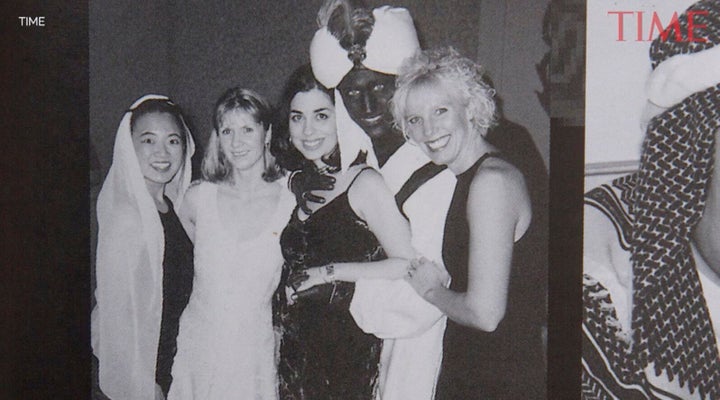
Katie Telford, Trudeau’s chief of staff and confidante who was travelling on tour with him, got on the phone and started reaching out to key caucus members from ethinic communities. Calls were placed to Defence Minister Harjit Sajjan and parliamentary secretaries Omar Alghabra and Greg Fergus, for example. Working against the clock, Trudeau broke the news to them, said he had shown bad judgment and that he knew this would be a very bad and serious story.
Alghabra, the incumbent for Mississauga Centre, who was canvassing at the time he got the call, said Trudeau told him he knew he was going to hurt and offend many people, and he asked for advice.
Kate Purchase, the Liberals’ chief content strategist, pushed to have Trudeau respond quickly to the story. The team travelling with Trudeau suggested a press conference on the tarmac. John Zerucelli, the national tour director, thought it would look too dark and a response from the plane would mark the urgency and severity of the situation.
In an awkward scrum, Trudeau, donning a navy jacket for the occasion, told reporters that in 2001, when he was teaching at West Point Grey Academy, he attended the school’s year-end Arabian Nights-themed gala.
“I dressed up in an Aladdin costume and put makeup on,” he said to the journalists facing him in the aisle of the airplane. “I shouldn’t have done that. I should have known better but I didn’t. And I’m really sorry.”
He repeated that line several times, often ending his sentence with a half smile. When asked whether he’d done this before, Trudeau offered that he had “dressed up” for a talent show in high school and sang Day-O (The Banana Boat Song) “with makeup on.”
“I didn’t think it was racist at the time, but now I recognize it was something racist to do and I am deeply sorry,” he said.
“I’m pissed off at myself for having done it,” he later added. “I wish I hadn’t done it, but I did it, and I apologize for it.”
The scrum was shut down after 14 minutes.
Before he turned on his heels to return to the front of the airplane, Trudeau was asked whether he was holding himself up to the same standard to which the Liberals were holding Conservative candidates.
“If everyone who is going to be standing for office needs to demonstrate that they have been perfect every step of their lives, there is going to be a shortage of people running for office,” the Liberal leader said.
For the next several days, the Liberal opposition research team was silent.
“We had to show a bit of humility,” one adviser noted.
NDP Leader Jagmeet Singh was wrapping up a town hall on health care in Toronto when reporters’ phones started buzzing with the news of Time’s scoop. When he opened the floor to questions, he had not heard of the scandal. If he was surprised, he didn’t show it.
Singh took a deep breath and said it was “troubling” and “insulting” but it was up to Trudeau to answer for his actions and what it said about his feelings toward people who, because of the colour of their skin, face barriers in their lives.
He would later hold an emotional press conference after he had seen the brownface photograph, speaking directly to racialized Canadians who he said might feel like giving up on Canada or question their self-worth.
Scheer’s response was markedly different. Standing in front of his plane, the Conservative leader, who had just landed in Sherbrooke, Que., spoke for one minute and took no questions.
“Wearing brownface is an act of open mockery and racism. It was just as racist in 2001 as it is in 2019,” he said. What Canadians had seen was someone who showed a “complete lack of judgment and integrity,” the Tory leader said, “and someone who is not fit to govern this country.”
But few could picture Trudeau as a racist. That he liked costumes too much, yes; that he lacked judgment, likely. But he had spent nearly four years governing Canada. He had announced funding to combat anti-Black racism, welcomed more than 25,000 Syrian refugees, increased immigration numbers and wrapped himself in multiculturalism and diversity. Canadians would not be convinced Trudeau was racist.
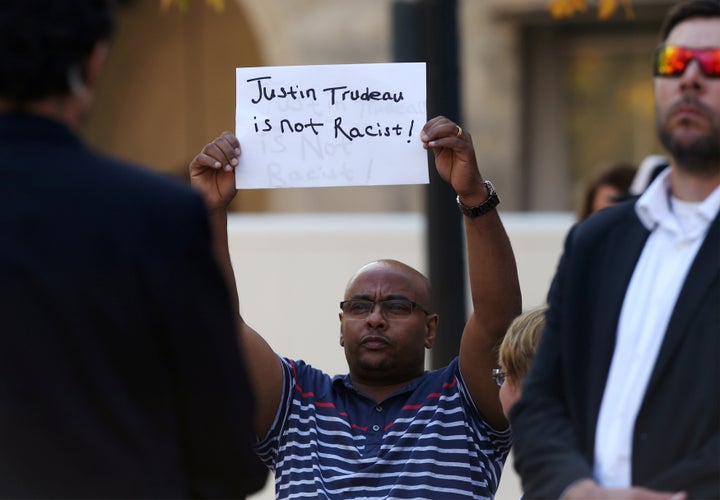

The next day in Winnipeg, for the first and only time during the campaign, Trudeau’s schedule was completely rejigged. The morning’s announcement was cancelled as Trudeau phoned community leaders and more members of his caucus. He also held a one-way conference call for all 338 candidates. “It was clear that folks were going to have different reactions across the country … and he needed to talk to them directly,” a senior Liberal adviser said.
The Liberal leader needed caucus defenders, and no dissenters.
Butts, who was back with Trudeau working on crafting the campaign’s narrative, spent an hour on the phone that morning with the Liberal leader and a wider group of the senior team. He told his old university buddy that he needed to go out there and take every reporter’s question “until the last dog dies.”
Butts, Purchase and Matt Stickney, the national field co-ordinator who was concerned about volunteer engagement, all pushed for questions to be answered in a public square — something another team member described as an “enormously risky decision.” But Trudeau was strongly in favour.
By then, Global News was reporting a third instance of racial makeup, one that came as a complete surprise to the campaign team when the news outlet had phoned the night before requesting comment.
“I think what was missed when he scrummed on the plane was a deeper acknowledgement of the hurt it was going to cause people.”
- Liberal source
The Winnipeg press event would be an opportunity to reset Trudeau’s response.
“I think what was missed when he scrummed on the plane was a deeper acknowledgement of the hurt it was going to cause people,” one team member back at headquarters offered.
That afternoon, Trudeau walked from his hotel to the Old Market Square. With Manitoba candidates behind him, he spoke to racialized Canadians who, he noted, “face discrimination every single day.”
As he talked about what he had done and the hurt he had caused, a crowd of people started to surround him.
“We did not pull that crowd. It was a naturally forming crowd of people who came to listen to what the PM had to say,” one senior team leader said.
“It was at that point that I knew that the situation was going to be OK,” he added. “Because Canadians understood what he was saying and accepted what he was telling them. … There were at least 300 people there, and all of those people were not Liberal soldiers, those were citizens who just happened to be in downtown Winnipeg and were just listening to him.”
The Liberal leader spoke with more humility than he had shown the previous night. He seemed shaken. Trudeau had, at least momentarily, stopped playing Justin Trudeau.
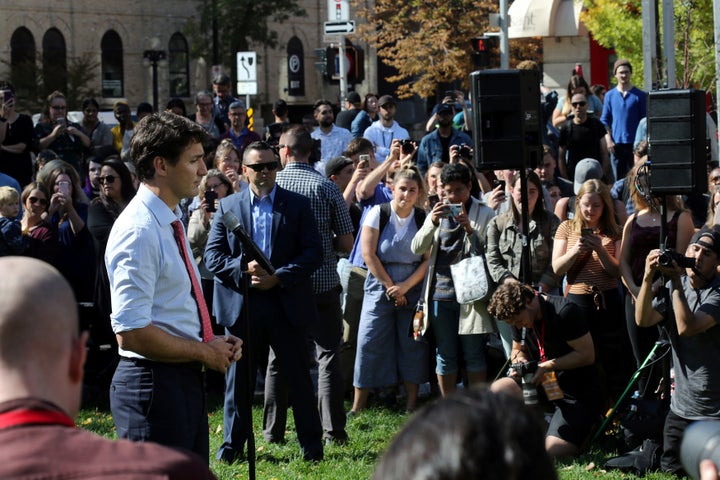
That night, a planned rally in Saskatoon was turned into a town hall, with the friendly crowd accepting the prime minister’s apology.
What to do next was the source of “wide-ranging discussions.”
At least one member of the campaign team, close to Trudeau, felt the prime minister needed to keep apologizing and meet with members of the Black community. Others, including Butts, argued that the campaign needed to move on or it would never be able to.
The latter argument won the day. Trudeau was back on the campaign script Friday announcing the Liberals’ measures on gun control.
“We didn’t want to put people in a position where they needed to be part of his redemption.”
- Liberal adviser
Trudeau did make calls and he participated in at least one meeting with racialized Canadians but the campaign chose not to “overly publicize them.”
“We didn’t want to put people in a position where they needed to be part of his redemption,” said one adviser.
The team had also considered delaying the announcement on gun control. At the time, the Liberals expected their firearms proposal to be a significant part of their pitch to voters. They worried they were stepping on a core campaign message.
“But we were like, look, if he’s not able to deliver this and sell it, it’s not going to be better on Saturday and Sunday, so we just have to push forward here,” said another source.
“And, we also knew what was coming next week. Whether we wanted to engage with it or not, that next week was going to be about climate change.”
THE MARCH
Swedish teen activist Greta Thunberg planned to visit Montreal on Sept. 27 and take part in what would be a massive march against climate change.
Butts was adamant the week should be spent on climate policy. In his mind, the fight was on the progressive side, with potential NDP and Green supporters who needed to see that while, yes, Trudeau’s record wasn’t perfect, the Liberal leader was proud of it and wanted to do more to address climate change.
The environment was a vulnerability — Trudeau had bought a pipeline and committed to the expansion of Trans Mountain — but it could also be turned into a strength, a “sword issue,” if the Liberals spent enough time on it.
According to several sources, Butts was the driving force behind the Liberal leader’s meeting with Thunberg and Trudeau participating in the march.
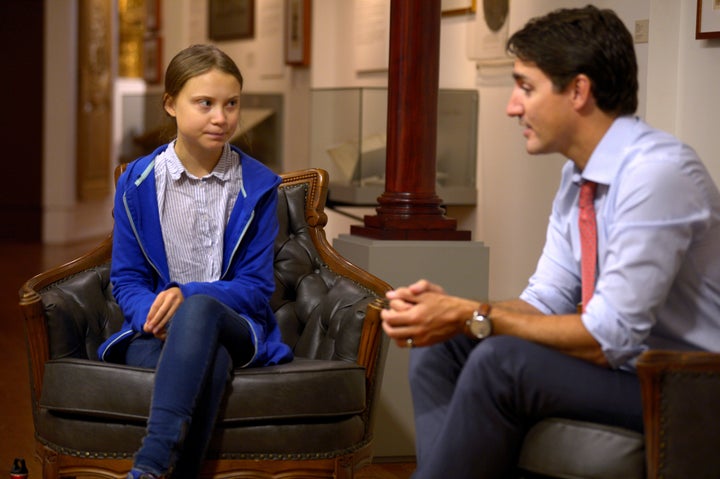
Others around the table felt both activities were too risky.
“It was not without risk to sit down with Greta. It was not without risk to march in Montreal. We could have seen both of those things going way differently.”
The march made people nervous. “All the elements of protesting society would be there, so obviously it put the RCMP on edge and everybody else on edge,” one adviser said.
Some suggested a middle ground. Perhaps Trudeau could go to a smaller march, where the risk of being confronted would be minimal? Treat it like “the Tories treat Pride,” said one person recounting the debates.
In the end, Butts prevailed.
It was also what Trudeau wanted. He felt there was never going to be a scenario where he wouldn’t walk in the climate march in his hometown. He wanted to participate with his family.
By then, the Liberals believed they were not going to lose any votes to the Conservatives on stopping the carbon tax. Clear lines were being drawn, and the Grits wanted voters to know clearly where they stood.
The meeting with Thunberg went better than the inner circle expected. It was friendly, and while she publicly called on Trudeau to do more, she qualified her comments by saying all leaders should. The Montreal march — with 500,000 people in the streets — passed without much incident. The RCMP apprehended one protester for throwing eggs.
None hit the Liberal leader.
Heading into October, despite blackface and the climate marches, numbers remained stagnant. The Liberals’ pollster, Dan Arnold, joked that when writing his daily polling memos he spent a lot of time thinking of new ways to say “the race is tied, the race is deadlocked, nothing has changed, it is neck-in-neck.”
That would change, at least in Quebec.
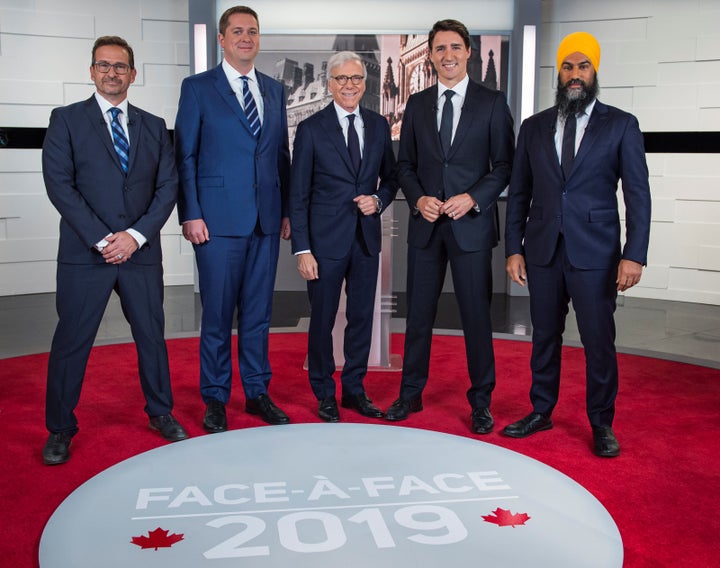
Trudeau had decided to participate in only official events organized by the Leaders’ Debates Commission, which his government had set up after campaigning on the issue in 2015. He opted out of a debate organized by Maclean’s magazine, as well as one by the Munk Debates, which forced its cancellation.
Trudeau, however, made an exception for the TVA debate. Team Trudeau felt it could not ignore the popular private French-language TV network nor could it do without the supporting coverage from its sister publications. (TVA and its cable channel LCN are owned by Quebecor, which also runs Le Journal de Montréal, Le Journal de Québec and the commuter paper 24 Heures, a reach that adds up to about half the province’s population.)
The TVA debate turned out to be a terrible evening for Scheer. He was attacked for his socially conservative positions, most prominently his view on abortion, with the Liberal, NDP and Bloc Québécois leaders all on one side of the issue and Scheer on the other. On medically assisted dying, same-sex marriage, pipelines and the environment, the Tory leader was out of step with Quebecers.
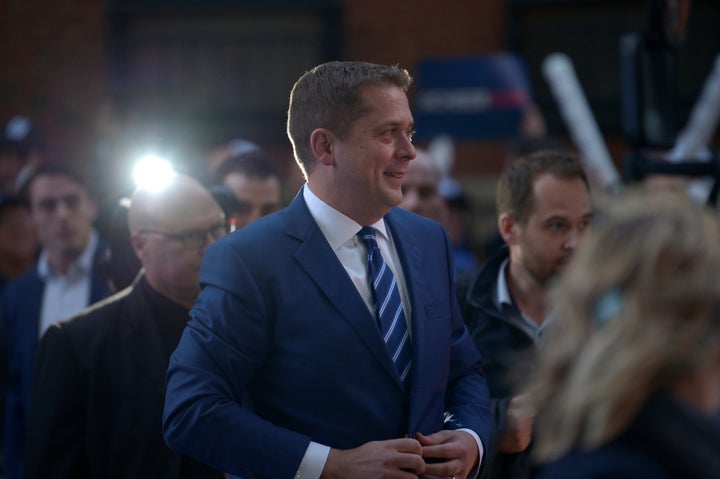
“The Tories thought that Andrew Scheer would benefit from getting known, but the more people learned about him, the more they turned on him,” said one adviser, who’d attended the Grits’ Quebec focus groups. In phone calls, voters expressed concern with the Tories. “They were afraid of the Conservatives. They saw them as right-wing extremists.”
The debate sank Conservative numbers in the province but also contributed to the rise of the Bloc.
Bloc Québécois Leader Yves-François Blanchet was a good debater. He spoke convincingly. And neither the Tories nor the Liberals, who had gambled so much on Quebec’s being the pathway to victory, saw him coming.
“Once we hurt the Tories’ chances of making gains in Quebec, we did not profit. … Those voters went over to the Bloc Québécois,” said one Liberal organizer. “In part, because of Bill 21 … in part, because of the English debate and [of Quebec Premier François] Legault’s comments.”
The commission’s debate in English came the following week.
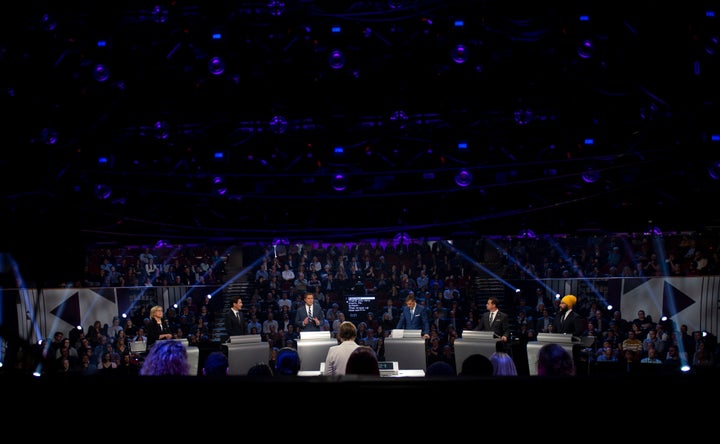
(Editor’s note: HuffPost Canada was one of the media organizations that produced the English and French debates as part of the Canadian Debate Production Partnership. This production group independently and confidentially created the format and screened questions from Canadians. Debate co-moderator Althia Raj asked the leaders about Bill 21.)
Trudeau did not perform as well as some on his team had hoped. While Scheer’s initial attack (“Mr. Trudeau you are a phony, you are a fraud, and you do not deserve to govern this country”) took the Liberals by surprise, it was Jagmeet Singh who emerged that night’s winner.
Expectations had been low going into the debate, but Singh outperformed. He looked comfortable, authentic, had good zingers (describing Trudeau and Scheer, for example, as Mr. Delay and Mr. Deny on climate change policy) and talked about economic inequality in ways people could relate to.
While Singh’s performance boosted NDP numbers and morale — and made the Liberals nervous about vote splits — the party lacked the funds to support their leader’s performance with advertising that could have increased his impact in English Canada.
In Quebec, the English debate caused other headaches for the Liberals. On a question about Bill 21, Trudeau had tried to show he was more willing to protect minority rights than Singh.
The next morning, TVA personality and former leader of the Action démocratique du Québec Mario Dumont exploded, accusing Trudeau of saying one thing in English and another in French.
“He should have just re-explained his position and moved on to other things.”
- Liberal adviser
In French, and so far during the campaign, Trudeau had said he had no intention of intervening to fight the law “at this time.” But in English, he said “a federal government might have to intervene on this.” Trudeau had suggested it was the duty of any prime minister to leave the door open to intervention. Dumont suggested Trudeau hadn’t dared make his position as clear to Quebecers.
“He didn’t say anything differently, but he turned it into an attack against Singh,” one Liberal adviser said of his leader’s position. “He should have just re-explained his position and moved on to other things.”
Dumont’s morning rant encouraged Legault to come out swinging.
“I find it pretty special that Mr. Trudeau comes and says he’s ready to contest a law against the popular will of Quebecers,” the premier told reporters on his way to question period that day. “I find this very regrettable. What I saw last night is that Mr. Trudeau boasted that he was the only one ready to challenge Bill 21, as if he wanted to distinguish himself, in English, from the other leaders.”
Legault, some Liberals believed, had just given legitimacy to the Bloc. Nationalist voters had only one choice left. Scheer had been rejected, and among supporters of Bill 21, as one Liberal put it, “for Mr. Singh, unfortunately, all they see is the turban.” The Bloc’s wave had begun.
Away from the camera flashes and mainstream television headlines, other campaign messages percolated. A lie took centre stage in a way rarely, if ever, seen before in modern Canadian elections. While it festered on the Internet, the parties engaged in more traditional slugging, some more ethical than others.
At the end of September, The Globe and Mail published a profile of Scheer that suggested the Conservative leader was misrepresenting himself as a former insurance broker.
“His office said he was an insurance agent. He was not,” the paper wrote. The Globe had found no evidence Scheer had obtained the required licence.
Scheer tried to explain. He had received his accreditation but “left the insurance office before the licensing process was finalized,” he said. The industry association said Scheer completed one of four courses. The Liberals jumped on the issue, saying Scheer had “repeatedly misrepresented himself to Canadians.”
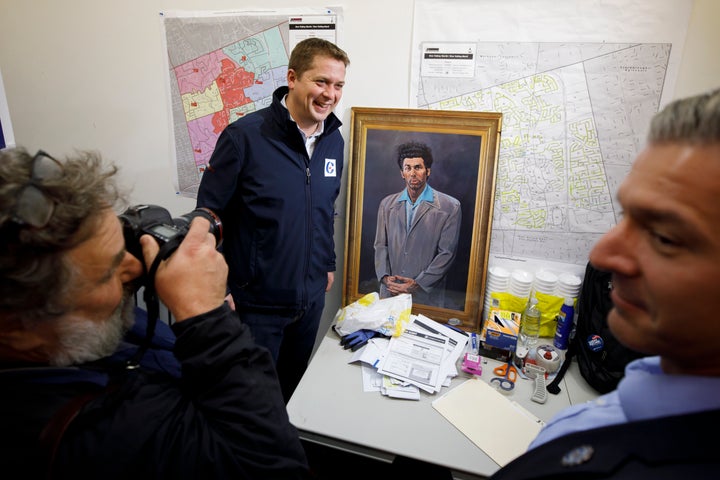
The Liberals also let the Globe know that they suspected Scheer was an American citizen. When asked, the Conservatives admitted their leader was a U.S. citizen but said he had begun the process of renunciation in August. Scheer said he’d never spoken about it because no one had asked him.
The Tories had, in the past, made a big issue of other leaders’ holding dual citizenship, including the French citizenship of Stéphane Dion and Thomas Mulcair. Scheer, the Grits noted, had penned a blog post asking his own constituents how they felt about then governor general Michaëlle Jean’s second citizenship.
Liberals hoped the hypocrisy would be apparent — all the more so because Scheer and the Conservatives had spent months calling Trudeau “not as advertised.”
“Could be the GST. Could be something else”
Several times during this campaign, the Conservatives spun the truth.
Toward the end of the campaign, Scheer accused the Liberals of wanting to form a coalition with the NDP and floated the idea that the parties would raise the GST to 7.5 per cent or cut the Canada Social Transfer to the provinces to pay for their spending plans. The suggestion was unfounded.
The Conservatives’ communication director, Brock Harrison, said the Tories were guessing. “Could be the GST. Could be something else,” he tweeted.
But one of the most damaging fibs, in the Liberals’ minds, was an early attack that claimed the Grits would impose a hefty tax on residential home sales. On social media, the Conservatives called it “Trudeau’s hidden home tax.”
“Behind closed doors, Justin Trudeau’s Liberals proposed a secret plan to implement a tax on up to 50% of the profits on the sale of your home,” the Conservative Facebook ads stated.
Ads aimed at Chinese Canadians
The Tories said they were quoting from the Liberals’ own “policy proposal” from November 2018. Toronto MP Adam Vaughan, who had prepared the document, said the Tories were misrepresenting it. It had come from a town hall on housing affordability and was meant to summarize ideas presented to MPs. The idea was of a sliding scale on a capital gains tax for the sale of principal residences, and the example given was of a 50-per-cent tax after one year of ownership, 25 per cent after two years, etc.
The Liberals never adopted the idea. It was not part of their platform.
The Conservatives also placed ads claiming Trudeau planned to legalize all drugs — which he said, on TVA, that he wouldn’t do. The ads were particularly aimed at Chinese Canadians in B.C. and Ontario, who were already opposed to Trudeau’s decision to legalize cannabis. “Trudeau legalized marijuana; he now intends to legalize hard drugs!” the ads stated in Chinese.
The Tories justified their claims, using select quotes from the Liberal leader. They also pointed to a private member’s bill by Liberal incumbent Nathaniel Erskine Smith calling for drug decriminalization as a way to address the opioid crisis — something a majority of Liberal MPs on the health committee also recommended.
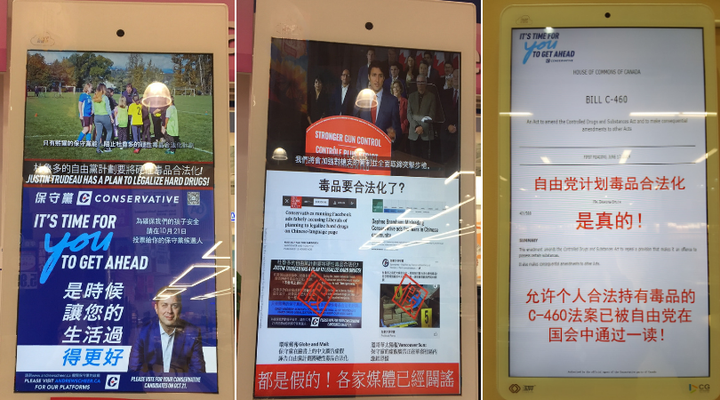
The Liberals fought back with ads of their own, in print and on TV, and they deployed cabinet ministers Mary Ng and Bill Blair, a former Toronto police chief, to speak to Chinese-language media. Blair also spent considerable time fighting the same accusation in Punjabi media.
“It’s a complete lie,” Blair told HuffPost before a Liberal rally in Vaughan, Ont., in October. “It’s sad. I don’t like to have to run around telling people what isn’t true, but unfortunately, in this particular campaign, we are seeing people making stuff up.”
The Liberals would later be accused of making their own stuff up by stating, in multiple languages, that the Tories wanted to keep dangerous guns on the streets and were cozy with the gun lobby.
One Liberal ad in Chinese claimed: “Once the Conservatives are in power, these assault rifles will spread to the streets. The Liberal party will strengthen gun laws and crack down on gun crimes.”
The Liberals argued that their attacks were fair as they planned to ban assault weapons and the Tories would not.
The biggest “lie” in the campaign was an accusation that was hinted at — by a Globe journalist and by the Conservative party — but never said out loud.
For weeks, the Liberal camp kept hearing about another rumour circulating in Vancouver, that Trudeau had slept with a student while he was a teacher at West Point Grey. The rumour, they say, is “categorically false,” “disturbing,” “complete nonsense” and “never happened.”
But the rumour took hold. Several media outlets poked around.
The Friday before the English debate, Globe reporter Marieke Walsh asked Trudeau to comment on what she called “unfounded rumours” about why he had left the school.
“I moved on,” the Liberal leader replied. Asked whether he signed a non-disclosure agreement, he said: “No.”

As anti-Trudeau activist Warren Kinsella used Twitter to tease a supposed Globe scoop, the Liberals asked Clive Austin, the former headmaster at the private school when Trudeau was teaching, to help calm down the rhetoric.
In a statement, Austin wrote that “with complete certainty … there is no truth to any speculation that he was dismissed.”
While the Globe never published a story, it had to deny speculation that a non-existent injunction barred it from releasing a story. The Buffalo Chronicle, a U.S.-based website known to publish fake news, wrote several unsourced articles with outrageous allegations. These made-up articles were each shared tens of thousands of times on the Internet.
Citing social media monitoring tool CrowdTangle, the National Observer said those stories reached more than 25 million people on different platforms.
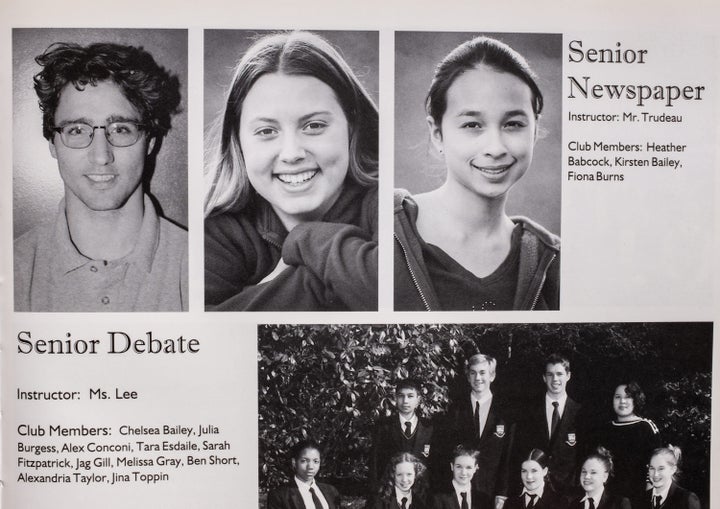
To what extent the Tories were involved in spreading disinformation online is unclear, but Scheer’s team privately floated the rumour directly to reporters. Before the English and French debates, the party publicly suggested it planned to address it with Canadians.
In a press release, on Oct. 7, the Conservative Party questioned “why exactly” Trudeau left his teaching job at West Point Grey and said Trudeau “will have the opportunity tonight to tell Canadians the truth.” Scheer never raised the issue during the debate.
Before the French debate, the party also teased “an important statement about Justin Trudeau’s past behaviour.” It turned out to be a Tory candidate discussing the SNC-Lavalin affair.
“We took a lot of heat from Conservatives and partisan conservatives when we would accuse [Conservative campaign manager] Hamish Marshall and the Conservative party of engaging in far-right American-style tactics, but what we are just talking about it is exactly that,” a senior Liberal told HuffPost.
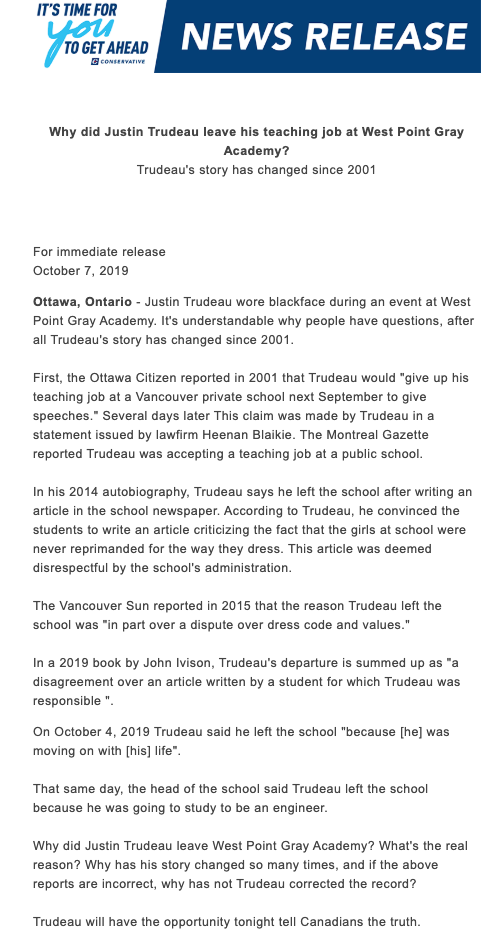
Policy attacks usually have some kernel of truth, another Liberal noted. This was not the case.
“I ... don’t think anyone was expecting the Conservatives to put out a press release about a lie — and a deeply offensive lie,” Purchase said.
When pressed by reporters at different media availabilities about his party’s role in spreading misinformation, Scheer dodged answering each time.
The Conservative platform
On Oct. 11, after all the debates were over, the Conservatives released their platform and fiscal plan, as reviewed by the Parliamentary Budget Officer. The PBO’s analysis, a new process launched under the Liberals, would give the public and the parties a better sense of how much their proposals would cost. It also meant it was harder to pledge to balance the books — say, in five years as the Tories had promised — without outlining how the government would get there.
When the Liberals obtained a leaked copy of the Tories’ plan, they rejoiced. The Conservative platform confirmed what Trudeau and the Liberals had been alleging during the campaign, that an Andrew Scheer government would cut public services, that he would govern like Doug Ford.
“It gave real life and colour to what we had been talking about, and they did it themselves,” Broadhurst said.
Not only did the Conservatives’ platform include $14 billion in unidentified cuts over five years, it also included an $18-billion cut from the infrastructure budget. Before the Conservatives had a chance to frame their announcement, the Liberals were already telling reporters that the Tories’ platform included $53 billion in cuts to programs.
The Conservatives were livid.
“I think the CPC handed us a majority,” one senior Liberal told HuffPost at the time. “Do you want investments in the middle class or four times Doug Ford’s cuts? That’s going to kill them in Ontario. It can be localized everywhere.
“Ads, speeches, mailings, digital comms. Eight days everywhere.”
The Liberals planned to close the campaign with a hard push, and the Tories’ platform seemed to re-energize them. Trudeau covered 48 events in the last 10 days, almost half of the 108 events in the entire campaign.
The Liberal leader was doing five or six events a day compared to three or four by Scheer. “We had to break through on the Scheer-cuts aspect, connect that to Ford. I think that’s an important part of what happened,” another Liberal said.
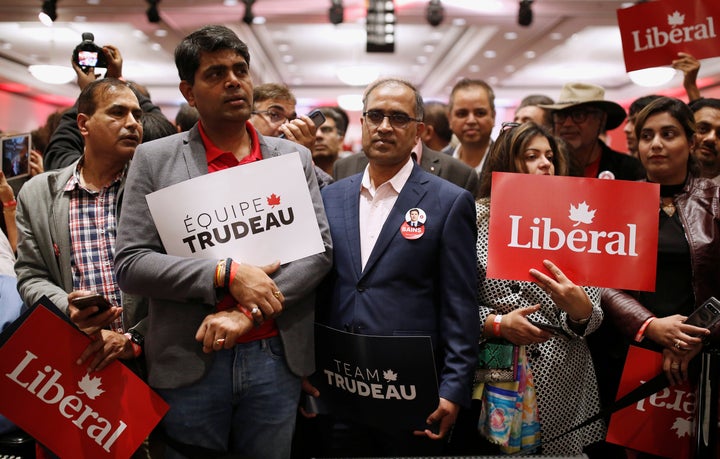
Trudeau had a new stump speech for Oct. 12. The party had organized a rally in Mississauga, Ont., in a conference centre near the airport, where some 2,000 supporters were gathered. They planned to film a momentum-building closing ad, much as they had done with a much larger rally in Brampton, Ont., in 2015.
The themes would be similar: a packed room with a diverse crowd, Trudeau on stage with his family and an energetic and positive speech motivating volunteers and hopefully sending Liberal voters to the polls.
Report of gun sighting
But before Trudeau took the stage, a bus driver reported seeing a man with a gun. The leader’s speech was delayed as the RCMP evaluated the situation and security officials decided how to respond.
The Liberals wanted to do the event, but, at first, the RCMP resisted.
“If they [the RCMP] had said no, we would have listened to them,” said a senior Liberal.
Nobody wanted to put anybody’s safety in jeopardy, he said. “But they figured out a path forward.”
Trudeau’s spouse, Sophie Grégoire Trudeau, who was supposed to introduce him, did not go on stage. Neither did their children. Instead, Trudeau emerged wearing a bullet-proof vest surrounded by heavy security. And the show went on.
It was the only “direct” security threat the prime minister faced during the campaign.
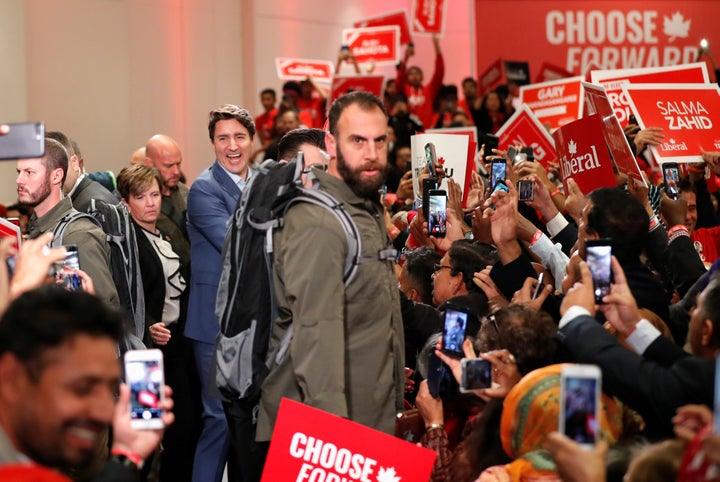
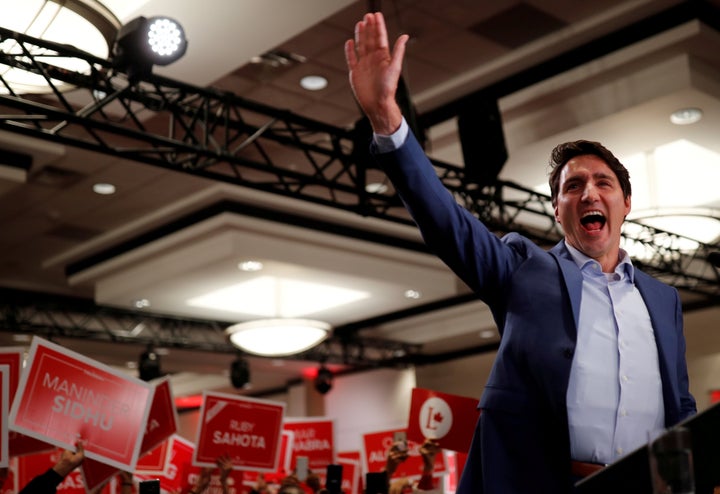
On Oct. 13, Jagmeet Singh was still riding the upswing from his debate performance and basking in the adoration of one of his largest crowds.
About 700 people had crammed into the Grand Taj Banquet Hall in Surrey, B.C., where Grand Chief Stewart Phillip, president of the Union of B.C. Indian Chiefs, and his spouse, Joan Phillip, the NDP candidate for Central Okanagan–Similkameen–Nicola, praised him for his inspirational leadership and said he reminded them of the NDP’s beloved former leader, Jack Layton.
After Singh gave his stump speech and jumped on stage as people chanted his name, he took reporters’ questions. A few days earlier, he’d outlined his priorities for supporting a Liberal minority government, having ruled out working with the Tories in August.
Asked whether he would try to form a coalition government with the Liberals even if the Conservatives won more seats, Singh responded: “Oh, absolutely. Because we are not going to support a Conservative government. We are going to fight a Conservative government, we’re going to fight it all the way.”
Singh’s response caught his senior adviser, Della Matia, off guard. She felt strongly that strategic voting was not a good card for the NDP to play and that it had contributed to the party’s muddled message in 2015.
The next morning, Singh was trying to put the toothpaste back into the tube.
“That was not my position,” he told reporters, from Granville Island in Vancouver, about his earlier coalition comments. “My position is this: We have a number of priorities. I want Canadians to know that they can vote New Democrat — vote as many New Democrats as possible — and all the commitments that we told you about, all our priorities that we told you about, we will fight hard to make sure that they are put in place.”
Some in the Conservative camp weren’t exactly sure what to do with Singh’s coalition talk. Should they capitalize on it, as former prime minister Stephen Harper had done in 2011? Would swing voters come to their side, afraid of an NDP-Liberal alliance? Or would they just vote for the Liberals to avoid a coalition government?
‘Crystal-clear choice’
When Scheer faced reporters in Winnipeg — having decided to stick to the tour itinerary despite a massive snowstorm leaving 21,000 Manitobans without power and the province in a state of emergency — the Tory leader was ready to jump on the anti-coalition bandwagon.
“Canadians now have a crystal-clear choice between a Trudeau-NDP coalition that will raise taxes, run endless deficits and make life more expensive,” he said, “and a Conservative government, majority government, that will live within its means, lower taxes, put more money back in your pockets.”
“I am asking Canadians for a majority mandate,” Scheer later repeated. “I do not believe that Canadians want a … government where Justin Trudeau may be the spokesperson but the NDP are calling the shots.”
Scheer would go on to repeat “majority” several times that week. A Tory majority that the Liberals believed would make a lot of progressive voters nervous.
Coming out of the long weekend, the Liberal numbers had not budged.
“I thought there was a real possibility on the Tuesday after Thanksgiving, after the numbers didn’t move, that we were going to lose ...”
- Gerald Butts, Liberal adviser
Butts had theorized that people would sit around Thanksgiving dinner, talk about politics and decide they didn’t want Scheer to be prime minister. But polls suggested a tie, and the NDP numbers were creeping upward. The projected seat count from Arnold, the Grits’ pollster, stood at 151 for the Liberals, 133 for the Tories.
“I thought there was a real possibility on the Tuesday after Thanksgiving, after the numbers didn’t move, that we were going to lose because people were going to go into the election weekend thinking we were going to win and not voting for us,” Butts told HuffPost.
Scheer, Ford ads in rotation
Butts and Tom Pitfield, the party’s chief digital strategist, and his team worked on new harder contrast ads. They tested a dozen versions.
“Andrew Scheer could win this election,” the ads stated. The digital ads were sliced into a radio spot that would run in swing ridings where the NDP could be spoilers.
Several versions of the ads, including one aimed at Ontario ridings with Scheer and Ford, went into heavy rotation. “This election is really close,” one of the ad’s captions stated. “He has promised 4 x more cuts than Doug Ford. He has promised to rip up our climate plan.” It continued: “Only the Liberal Party can stop Conservative cuts.”
Another more positive ad reminded centre-left voters of the bona fides of the Trudeau government — or, as the ad quoted from The Atlantic magazine, “the most successful progressive government in the world.”
The plan at the outset had been to corral progressive voters to the Liberals’ side. Would it work?
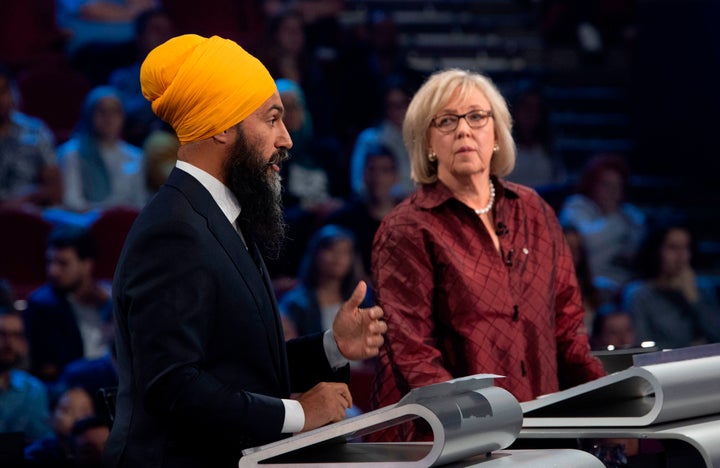
On the campaign trail, Trudeau rarely mentioned NDP Leader Jagmeet Singh or Green Party Leader Elizabeth May.
One adviser said Butts had a view that prevailed in the office that “progressives don’t want to see progressive parties fight each other.” So the party steered away from focusing on the NDP or the Greens and kept its attacks on the Conservatives.
On Oct. 15, in Fredericton, Trudeau spoke directly to NDP and Green voters, telling them if they wanted “progressive action,” they had to vote Liberal.
The next day, in Montreal, he floated the idea Scheer might become prime minister. If a Conservative government were elected, he said, it would be “truly unfortunate” for the fight against climate change. The Liberals’ own data suggested their potential voters in Quebec cared most about the environment.
“The only way to prevent that from happening is to vote for the Liberal Party,” he said.
The Obama effect
Five days from election day, the Liberal campaign got a huge boost.
Former U.S. president Barack Obama endorsed Justin Trudeau.
Trudeau was a “hard-working, effective leader who takes on big issues like climate change,” Obama wrote. “.... I hope our neighbors to the north support him for another term.”
Before the campaign, when Obama visited Ottawa and the two had a beer in June, he offered to assist his friend Trudeau, if he could. That led to discussions about a tweet.
Obama’s post was shared more than 45,000 times and liked more than 325,000 times. It trended on Twitter. Trudeau’s reply thanking Obama was seen 3.7 million times.
The party’s Facebook post about the endorsement reached more than 1.7 million people in less than 48 hours. Their Facebook page saw an increase of 1,300 per cent on engagement and gained the most followers in a single day during the campaign.
It was both the most successful tweet and the most successful Facebook post of the entire campaign.
“His endorsement was the first real positive lift we got in English, especially on social,” Butts said.
“It reminded progressives that he was someone that they liked,” Purchase said.
What it did, said another Liberal, was help validate people’s decisions. “Obama allowed people to feel OK with voting for Justin, especially after his behaviour.”
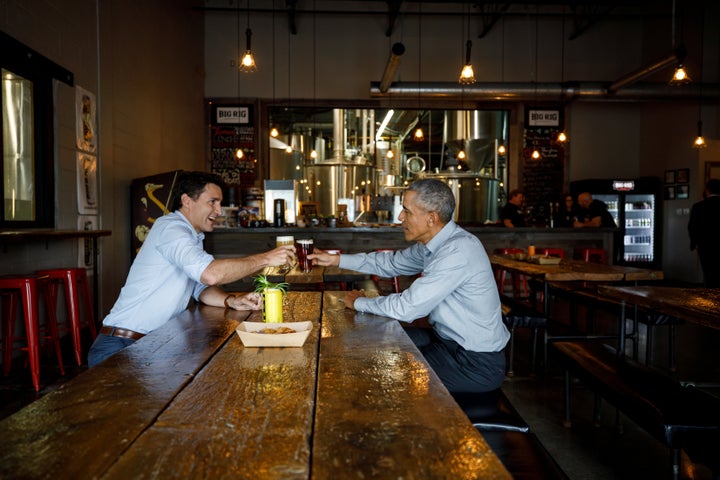
Over at the Tory campaign, the Liberals’ attacks tying Scheer to Ford and localizing infrastructure cuts seemed to be landing.
In Quebec City, where Scheer was starting his week, local media wanted to know what infrastructure projects a Tory government might cancel.
Conservative incumbent Gerard Deltell stood frustrated, with a page from the party’s platform in his hand and a gaggle of reporters in front of him.
“It is clearly stated, on page 98, in the second column, in the second paragraph, that we will maintain all the programs promised by the Liberal government,” he said in French. “It is written in black and white.”
“But where are you cutting, Mr. Deltell? Where are you cutting?”
The questions continued in Trois-Rivières, Que., Scheer’s next stop. The Tory leader had not intended to take any. As about 70 people crowded into a small campaign office — including more than a dozen media members — Scheer described his party as the only one that could “replace” Trudeau.
“Justin Trudeau and the NDP were talking openly about forming a coalition to hang on to power,” he said. “A coalition that would hike income taxes and send Quebec backwards. A coalition against whom the Bloc could do nothing. A coalition that Quebec can’t afford. That’s why we need a Conservative majority government.”
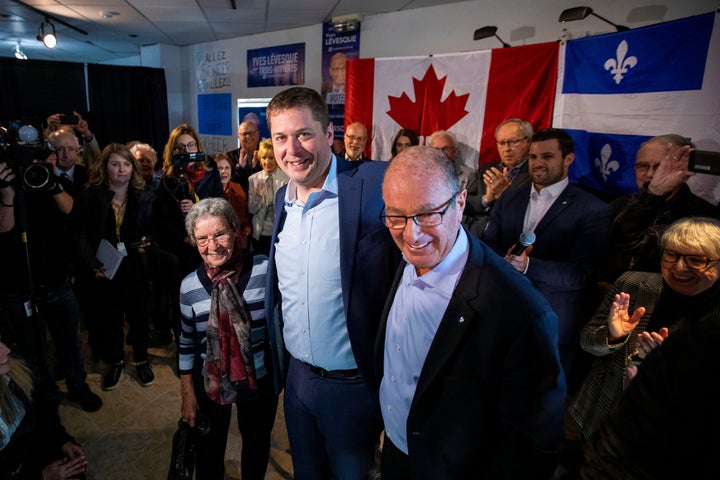
When Scheer tried to leave the office by the back door, he was cornered by local reporters and peppered with questions about the infrastructure projects in the region.
“There will be no cuts; it will be the same amount,” Scheer told a reporter who wanted to know about the city’s airport funding, which the Trudeau government had announced in August. “Our plan has the same amounts.”
While Trudeau was in Mississauga earlier that week dealing with the security crisis, most of his senior team was huddled in Ottawa plotting out where the Liberal leader’s tour should go.
The team decided what ridings to visit based on where they thought the Grits were competitive and could improve their standing, as well as where they could get the best pictures and the biggest crowd.
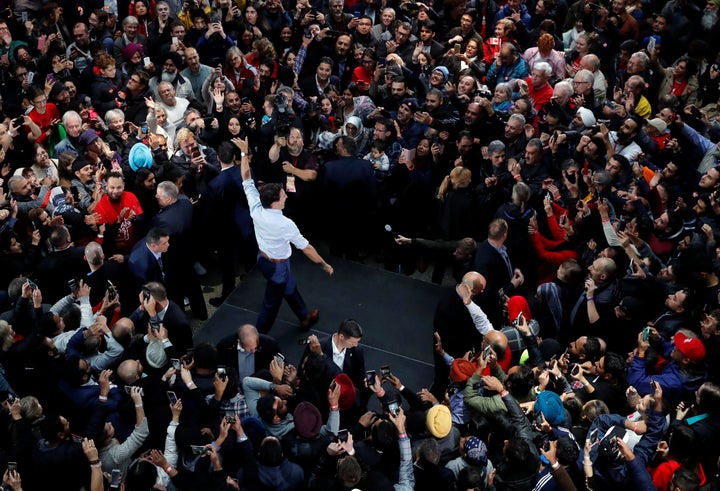
Data suggested that wherever Trudeau went, he temporarily bumped the Liberals’ polling numbers in the area by two to three per cent.
“It became like a basketball. If you weren’t there to catch the ball, then it would drop back down,” one senior campaign director said. “You had to be there to keep the ball bouncing.”
That explained why Trudeau spent quite a bit of time in the 905 region around Toronto. After Scheer’s numbers fell in Quebec, the Conservative leader’s only pathway to government lay in Ontario. Trudeau needed to fend off the expected approach and play offence for seats that they believed could turn red.
The leader’s tour focused on creating momentum. Showing Trudeau fighting hard for his job, taking nothing for granted.
The pictures the tour delivered showed Trudeau surrounded by people, hoping to give others the feeling of joining the movement. It re-energized volunteers and supporters, which in turn helped the party better identify and bring out its vote.
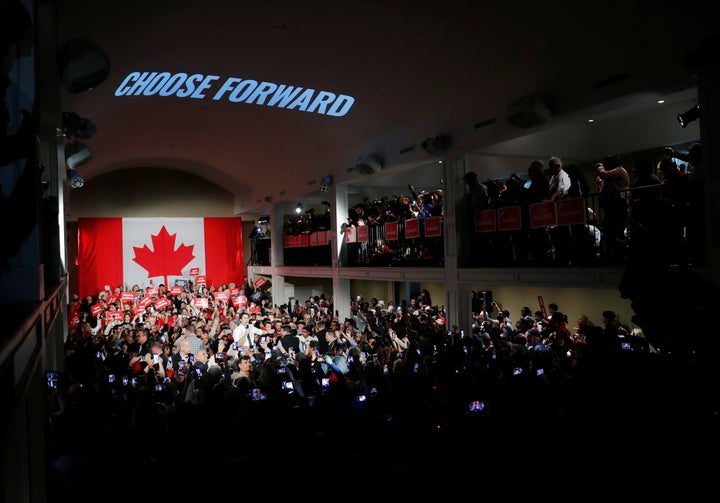
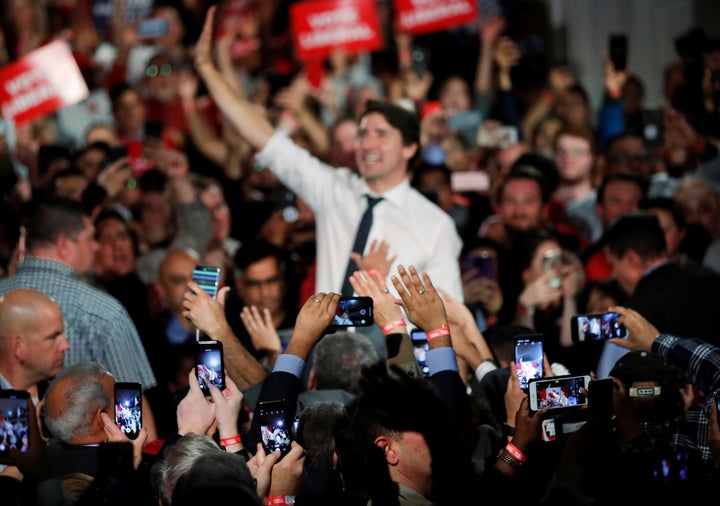
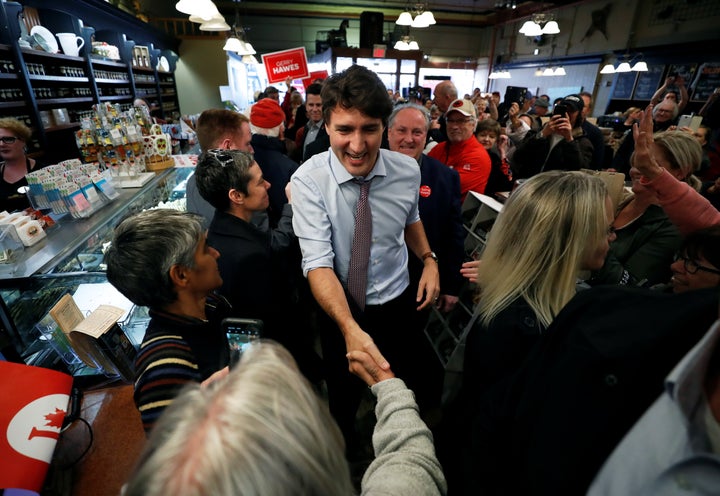
One preoccupation going into the campaign was voter turnout. Conservative voters are more enthusiastic, Stickney said. “They don’t like the prime minister, they want to vote him out,” he said.
The Grits found an advantage in their superior use of data — something both Liberals and Conservatives will attest to.
Pitfield credits the party’s national director, Azam Ishmael, for equipping the Liberals with the infrastructure needed to run digital and data-focus campaigns.
His company, Data Sciences, worked with the Liberals during the 2015 election. Over the past four years, Pitfield, Sean Wiltshire, and the rest of the team have worked on more than 20 campaigns in Canada, in France for Emmanuel Macron and in Britain for the Liberal Democrats, learning and adjusting their models. The Liberals have benefitted from that experience.
The programs that Data Sciences built supplement the party’s Voter Action Network and have become, as Pitfield describes, “part of the fabric of the party.” They are used for analytics, advertising, organic social traffic, training, field work, reporting and modelling.
“You don’t win close campaigns trying to convince people something they don’t believe.”
- Tom Pitfield, Data Sciences CEO and Liberal Party chief digitial strategist
Leveraging that data in a close campaign — in any campaign really — means resources can be allocated more efficiently. The 2019 election was a big technical win. The Liberals won 35 more seats than the Conservatives, with 1.3 million fewer votes. They won 27 ridings by less than five per cent of the vote.
“You don’t win close campaigns trying to convince people something they don’t believe,” Pitfield told HuffPost. “It’s totally inefficient and a waste of time. You win them by being efficient at finding and mobilizing people that already support you.”
What the programs allowed the Liberals to do was worth the equivalent of 725 people working eight hours a day during the 40-day campaign, said Pitfield.
The Grits made 14 million attempts to contact voters throughout the campaign — that’s door knocks, calls, web identification. In the final two weeks, the party made 5.5 million attempts.
“That is the big red machine people talk about,” said one Liberal. “It does exist.”
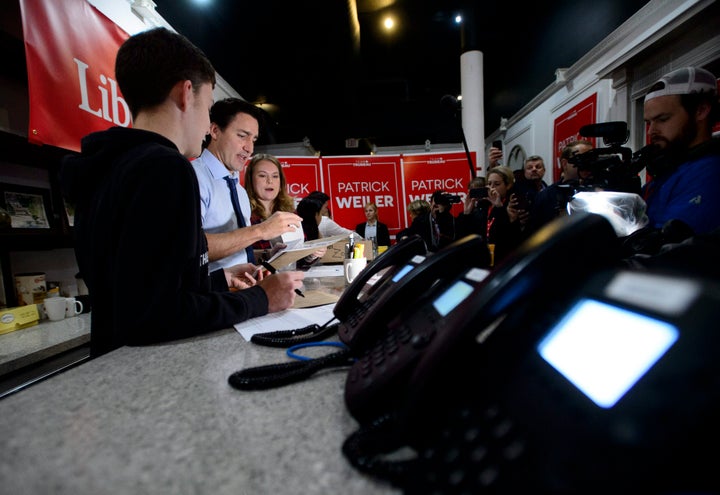
While Pitfield’s focus is on the digital side, it works hand-in-hand with old-fashioned tactics. Voters are much more likely to vote Liberal if someone shows up on their front porch explaining why they believe in Trudeau. The party estimates canvassing generates one vote per 14 contacts.
Four years of door-knocking, calls and digital outreach made the Liberals’ ground game much stronger in 2019. It is what some organizers, such as Stickney and national campaign committee co-chair Sylvie Paradis, credit for keeping many of the Liberals’ seats in Quebec, for example.
In Milton, Ont., where former Olympic medallist Adam van Koeverden bested Conservative deputy leader Lisa Raitt, the Liberals made 259,000 attempts to reach voters, including knocking on 187,000 doors. In the last three days, van Koeverden said his campaign visited 20,000 homes, and reached out to 12,000 voters on election day. He won by 9,318 votes.
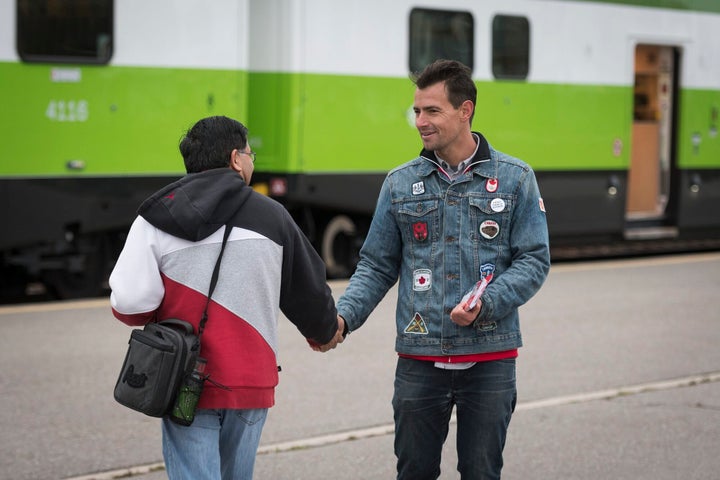
“We won it large[ly] because of Adam, but it is a self-propelling thing,” one senior Liberal said. “Adam’s door-knocking was so strong that he had the best data about what to target to whom.”
“These things are always won by little bits of everyone’s hard work,” Pitfield said.
Although the Liberals spent more money on radio and television ads, a large chunk of their digital budget advertising went to Facebook. In part, that was out of necessity, as YouTube and Google search were unavailable for advertising by political parties this year. (The two platforms opted not to comply with the government’s Election Modernization Act.)
The party tested ads on Facebook to see what worked best and micro-targeted their message to key groups. The Liberals used 25,000 different ad variants to reach out to voters. The Tories had 3,000 unique ads.
“The numbers don’t lie.”
- Matt Stickney, Liberal national field co-ordinator
During the last three days of the campaign, the Liberals spent more than $1 million on targeted advertising, including to about 30 swing ridings. These ridings were “silver” in the Grits’ ranking system of winnability, which ranged from diamond down through platinum, gold, silver, bronze, steel and wood.
The silver ridings were places such as Milton, where the party thought it could win on its way to a majority. Gold seats would be places they needed to hang on to to form government.
“The numbers don’t lie,” Stickney said. They are relied upon to figure out the path to winning and the path to majority. “That’s the math we focused on.”
The contrast ad, featuring Scheer and Ford that was released in the last week, was particularly powerful with potential voters, increasing support for the party by 2.5 to 2.7 per cent for those exposed to it. It was so successful, in fact, that some in the Liberal team argued it should be the closing spot.
But Pitfield wanted Trudeau, his friend, back into the narrative. He and Butts felt the Liberals should return to a hopeful message, one that was more on brand, and, in marketing terms, would make voters feel good about their purchase.
That closing spot, the one filmed in Mississauga with Trudeau urging everyone to “choose forward,” was viewed by 6.2 million people in the Grits’ target regions over three days.
It did better than the contrast ad with NDP supporters, increasing Liberal support with these voters by more than four per cent.
The party estimates those who saw or engaged with their get-out-the-vote ads were up to one and a half times as likely to go to the polls.
During the last 24 hours of the campaign, the Liberals saturated Facebook. Positive content isn’t shared as much as negative content, so they flooded the market.
Data from the party showed Liberal videos had 690,000 organic views on Facebook that day compared with Scheer’s 177,000 and Singh’s 99,000.
“That’s how you win a content war,” Pitfield said. “You just make sure your stuff is out there and being consumed on a daily basis.”
Another bombshell
As the Liberals planned their final sprint, they threw another bombshell into the Conservative camp. Documents leaked to the Globe showed anti-Trudeau activist Warren Kinsella’s firm had been hired to “seek and destroy” Maxime Bernier’s People’s Party. The story cited an unidentified source who said the Conservative Party had hired Kinsella’s company. He declined to comment.
Scheer did not confirm the story, nor did he deny it.
“We do not make comment about vendors that we may or may not have engaged with,” he responded during a press conference in Toronto.
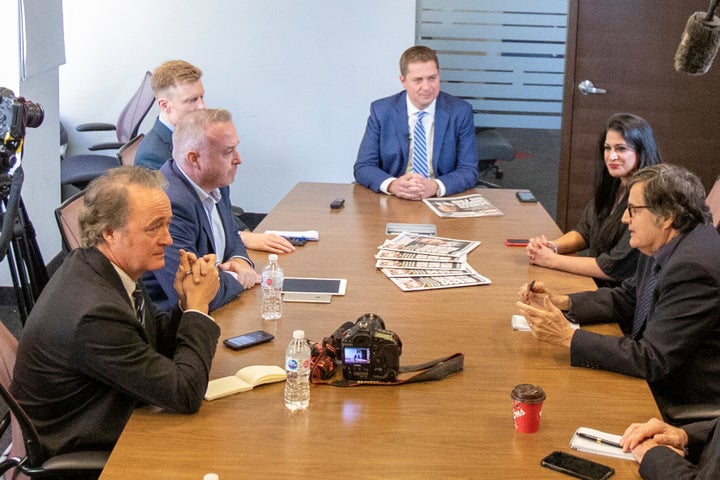
Kinsella had pushed the West Point Grey rumours on social media and strongly attacked the Liberal leader over his treatment of Wilson-Raybould earlier in the year.
Asked whether the Tories had hired Kinsella to attack the Liberals, Scheer also declined to answer.
He refused to answer 20 times when questioned on the topic.
On election day, some in Scheer’s camp were telling other Tories they expected to win.
When that information was relayed to the Liberals, they were puzzled. Their pollster projected a strong Liberal minority government: 163 seats for the Liberals, 118 seats for the Conservatives, 34 for the Bloc, 20 for the NDP and three seats for the Greens.
Those numbers had not shifted significantly in the previous week. If anything, their stats strongly suggested that the Tories had slid backward over the last few days.
Some Conservatives working in battleground ridings felt something was off. One Tory insider said party resources were diverted from seats the Conservatives expected to win to ridings that were less likely to flip. It was a gamble in Milton and in the Nova Scotia riding of Cumberland—Colchester, for example, that did not pay off. There, former Conservative MP Scott Armstrong lost his bid to return to Parliament by 453 votes.
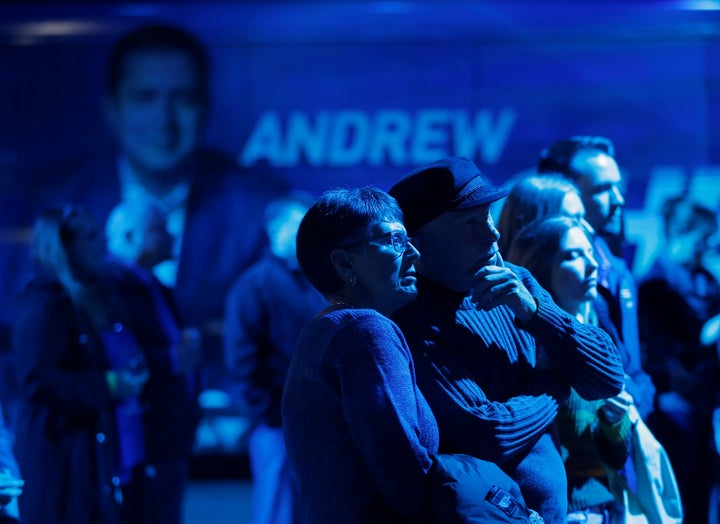
As the results trickled in on Oct. 21, Conservative operatives with lengthy campaign experience placed part of the blame on the once vaunted Tory machine. They had let their ground game advantage lapse and the Liberals were now far superior at data and getting their vote out. Changes will have to be made, several Tories told HuffPost.
On election day, the Liberals won 157 seats, the Tories 121, the Bloc 32, the NDP 24 and the Greens 3.
But could they have won by a larger margin?
In the crucial last leg of the campaign, Trudeau’s team chose, for the first time, to ignore its data and made a sentimental decision about the tour itinerary.
After waking up in Niagara Falls, Ont. and shaking hands with seniors at the Emerald Retirement Residence, Trudeau criss-crossed the country from the Hamilton Fire Department training academy to a Brantford Italian eatery to a rally in Milton. Then he boarded the campaign plane for a 2,000-person event in Winnipeg, followed by an 11 p.m. rally in Calgary, and then lights out in Vancouver.
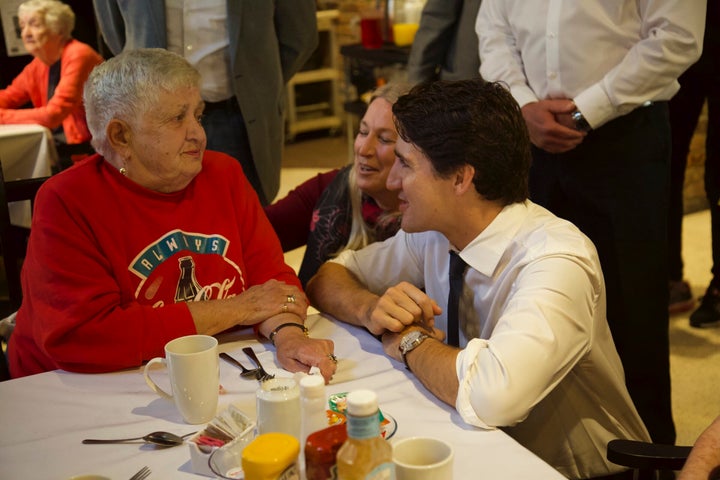
The decision to go to Calgary was greatly debated.
Butts argued against it, according to several sources. He thought there were no winnable seats in Calgary and that the tour should focus on a number of closer races in Ontario and Quebec that could have used a lift from the leader’s tour.
When asked about it, Butts didn’t want to comment on “internal campaign debates.”
“There are lots of them on every campaign. It’s true that data usually drives your decisions, especially in the final week. It’s also true that sometimes decisions are made for valid reasons that set the data aside,” he told HuffPost. “This was a team decision. I’m not going to second-guess it after the fact.”
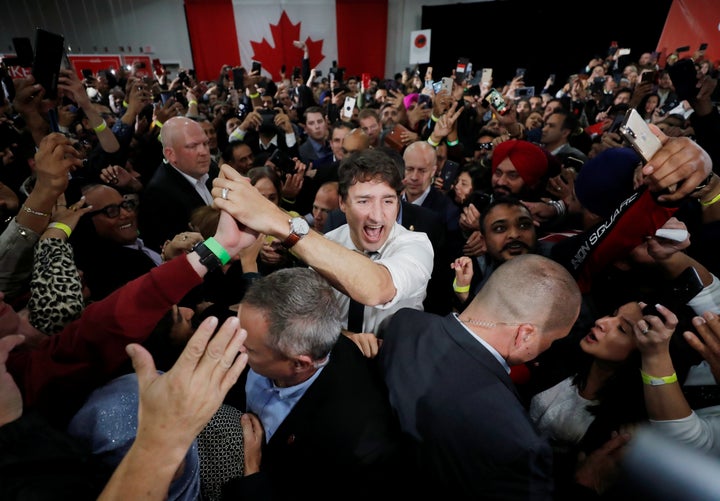
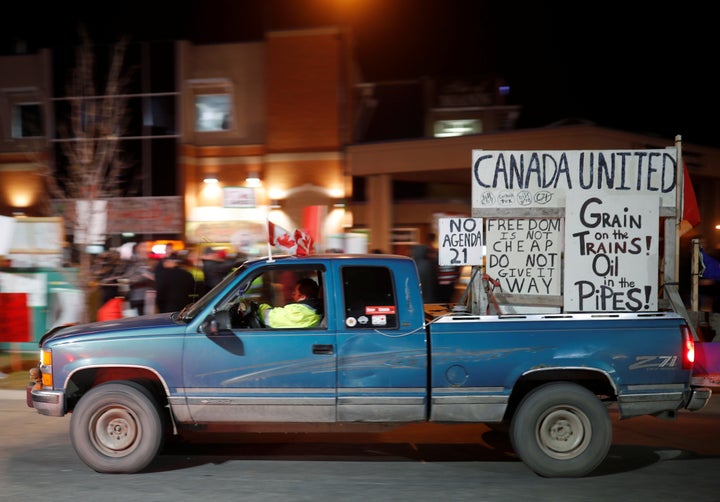
The Liberals lost a potential majority by fewer than 23,000 votes. In 14 ridings, the Grits lost by less than five per cent. Thirteen of those ridings — 11 in Ontario and Quebec — would have brought the Grits’ seat count to 170.
It seems unlikely that a different tour would have made up that gap. But even staff who favoured the trip to Calgary told HuffPost they feel a few more days in Ontario might have made a difference between a minority and a majority.
Of the seven ridings Trudeau visited during the campaign’s last 24 hours in Western Canada, the Liberals won one seat: West Vancouver–Sunshine Coast–Sea to Sky Country, a district they already held. Two rallies, in Calgary and Victoria, were in ridings they had no chance of winning.
“I’m glad that we did now, in retrospect, stop in Calgary, even though it didn’t produce a win,” Broadhurst told HuffPost. “Because we do have a challenge ... and we need to show that we’re not going to write off Alberta at this point. That is just not who we are.”
The strongest argument in favour of a Calgary visit was Trudeau’s desire to go. He felt it was important to send a message to Albertans, and to the rest of the country, that residents there mattered and that he would not forget them.
The firm rejection of the Liberals in Alberta and Saskatchewan contributed to them losing the popular vote. The Tories received 6,155,662 votes versus the Grits 5,915,950 — a difference of 1.3 per cent.
But to many members of Team Trudeau, what’s surprising is that the pounding was not worse. That despite beginning the campaign under the cloud of a potential RCMP inquiry and managing an internationally embarrassing scandal about a woke prime minister found wearing blackface, as well as attacks by the premier in Quebec, the Grits survived.
“What was remarkable is that we were able to handle every one of those crises the best we could and that we were able to finish where we did,” a senior team member said. “Because every one of those crises could have killed us.”
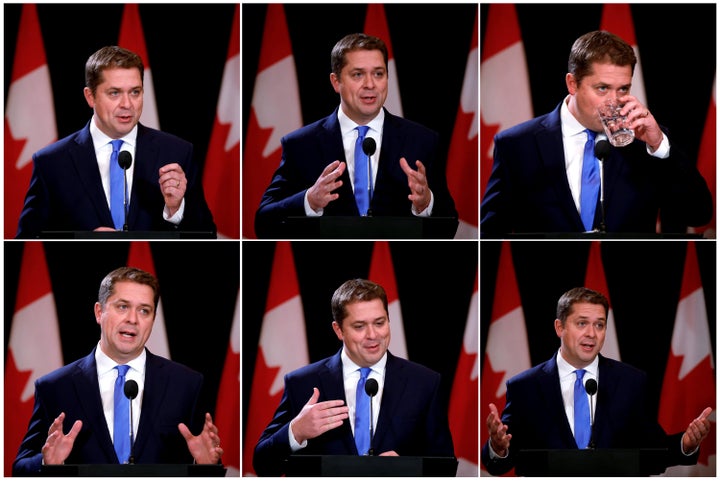
The Liberals threw Scheer and his mostly inexperienced team off their game with opposition research. They crafted a strong narrative that expanded their voter pool by beefing up Trudeau’s credentials on the environment, and they brought potential voters onside with targeted messaging.
“I think Canadians wanted Justin Trudeau to be prime minister, and part of that is they didn’t want Andrew Scheer,” Stickney told HuffPost. “Of course, I also think we ran a better campaign, from digital to field.”
Purchase said her takeaway is that “the country is a more progressive place than not, and that there is a real mandate for progressive change…
“I also think that [voters] also said ‘be humble and work hard — work harder,’” she said.
“I think he [Trudeau] heard both of those things loud and clear.”
